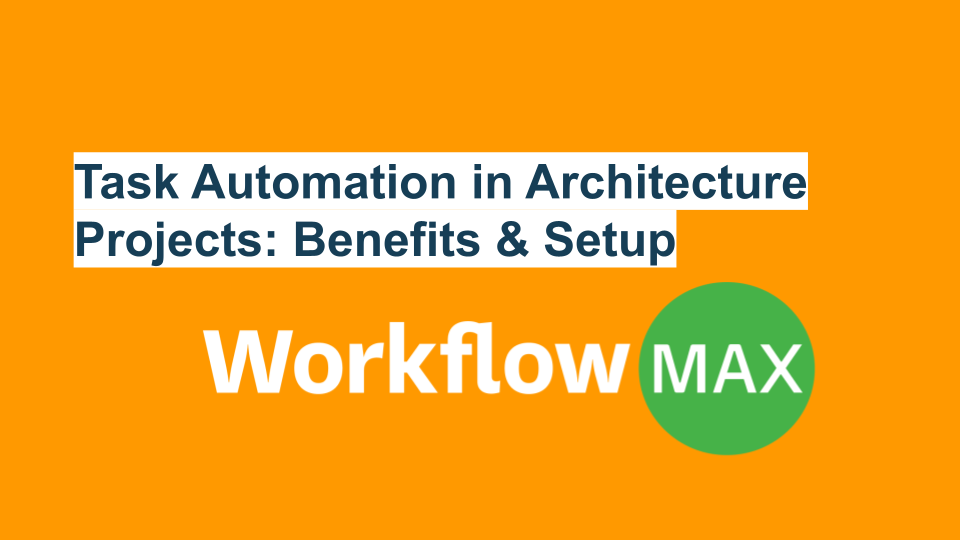TL;DR: Task automation transforms architecture projects by improving efficiency, accuracy, and sustainability. Tools like AI, BIM, and WorkflowMax streamline workflows, detect design issues early, and support collaboration through real-time data and centralised document access. Automation frees architects to focus on creativity and reduces manual work, improving profitability and client satisfaction. Integration with systems like IoT and digital twins enhances decision-making and resource management. While challenges like cost and resistance exist, phased implementation and training ensure smooth adoption. Future trends point to AI-driven design, smart buildings, and green innovations—all supported by WorkflowMax’s customisable, integrated tools.
Automation improves architecture projects through better efficiency, innovation, and sustainability. AI, Building Information Modelling (BIM), and advanced task management tools streamline workflows, improve collaboration, and enable precise project execution.
AI helps architects create detailed models and detect design clashes early. This cuts rework and speeds up projects, assisting teams to adapt to changes. BIM connects all project parts, giving you a complete view that leads to faster completion and better quality.
We support automation with customisable templates and notifications that match your specific needs. This flexibility ensures our software meets your unique business requirements.
When you automate routine tasks, you free up time to focus on creative designs and sustainability. Our client management and reporting tools show what works well and help you make smarter decisions.
Centralised document management makes important project files easily accessible, boosting team collaboration. Our seamless integration with Xero eliminates double data entry, keeping financial reporting accurate.
Automation transforms traditional processes into adaptive systems that respond quickly to challenges, helping create more sustainable and innovative architecture projects.
Tools and technologies driving automation
AI-driven generative design transforms architectural approaches. It creates detailed models easily, optimises layouts, and improves material usage. By analysing data, AI designs efficient structures that meet specific needs.
Enhanced Building Information Modelling (BIM) systems offer a complete project view. They link all design process parts, enabling smooth collaboration and precise execution. This connected approach creates efficient resource use and better results.
Real-time data integration strengthens modern architecture. It keeps information current, helping teams make quick, informed decisions. This supports adaptive project management and flexible workflows.
Effective task management platforms help organise work more efficiently. They track and manage project elements efficiently. Features like custom templates and notifications align everything with business goals.
Automation frees architects to focus on creativity and sustainability. It enhances traditional processes, making them more flexible and responsive. Automation saves time and drives innovation in architectural projects.
Benefits of automating tasks in architecture projects
Automation in architecture projects speeds up timelines, reduces errors, and enhances sustainability. By automating repetitive tasks, teams can focus on creativity and innovation without getting bogged down in manual work.
Advanced visualisation techniques, such as VR and AR, enhance client communication. These tools allow clients to experience designs in a more immersive way, leading to a more precise understanding and faster decision-making.
Automation fosters collaboration by streamlining workflows. With centralised document management, team members can easily access and share important files, improving efficiency and reducing delays. This seamless collaboration is crucial for keeping projects on track.
Sustainability improves as automation optimises resource use. AI-driven tools help architects design more efficient structures, minimising waste and promoting eco-friendly practices.
WorkflowMax supports these benefits with features like customisable templates and real-time performance dashboards. These tools align workflows with business goals, ensuring projects run smoothly.
Enhanced client management features boost client satisfaction. By automating communication and reporting, architects can focus on building strong relationships and delivering exceptional results.
Automation transforms traditional processes, making them more adaptive and efficient. It's about creating a workflow that responds quickly to challenges, ultimately leading to better project outcomes and happier clients.
Achieving integration and compatibility
Integrating automation tools with architectural systems like BIM, IoT, and digital twins improves efficiency and collaboration. Seamless APIs connect cloud services, ensuring smooth data flow between platforms.
Automation tools must be compatible with existing systems to work together in one place. This integration gives architects access to real-time data for quick, informed decisions. Our centralised document management stores all project files in one location, making collaboration easy for remote teams.
Connecting IoT devices with architectural software provides valuable insights into building performance, helping teams optimise design and resource use. Automation enhances these connections, creating a complete picture and enabling predictive maintenance.
Digital twins create a virtual model of the physical environment for simulations and analysis. When automation tools integrate with digital twins, they ensure accurate, up-to-date representations that aid project planning and execution.
Seamless integration promotes collaboration among stakeholders—architects, engineers, and clients. Cloud-based platforms make information sharing easy, reducing misunderstandings and keeping everyone aligned. Our robust reporting tools provide insights into productivity and performance, enabling teams to make informed decisions with data across hybrid project environments.
Overcoming challenges in automation implementation
Automation in architecture projects faces hurdles like initial investment costs, training needs, and resistance to change. These challenges require strategic solutions to ensure smooth adoption.
- Initial Investment Costs: Automation tools can seem costly upfront. Consider phased implementation to spread expenses over time. Start with high-impact areas to demonstrate value and justify further investment.
- Training Requirements: Successful automation relies on skilled users. Provide comprehensive training that covers both technical aspects and practical applications. Encourage team members to share insights and learn collaboratively to build confidence.
- Resistance to Change: Change can be daunting. Clear communication is vital to address concerns. Highlight how automation enhances roles rather than replacing them. Involve employees early in the transition process and showcase benefits through pilot tests to build trust.
- Integration with Legacy Systems: Compatibility issues with existing systems can arise. Plan carefully and explore middleware solutions for seamless integration. Ensure data quality and manage it effectively to avoid disruptions.
- Engaging Stakeholders: Early engagement with stakeholders helps in aligning goals. Use pilot projects to illustrate potential gains and foster buy-in. Demonstrating tangible benefits can ease apprehensions and promote cooperation.
By tackling these challenges head-on with thoughtful strategies, architecture firms can successfully embrace automation, enhancing efficiency and innovation in their projects.
Future trends in architectural automation
AI-driven optimisation is reshaping architectural design. By analysing vast datasets, AI creates more efficient structures that meet specific requirements. This technology streamlines processes, reduces waste, and enhances sustainability in building design.
Innovative building technologies are gaining traction. These systems improve energy efficiency, enhance occupant comfort, and support eco-friendly practices. IoT devices provide real-time insights, allowing for more innovative resource management and predictive maintenance.
Sustainability-focused innovations are crucial. Advances in materials and construction methods reduce environmental impact and promote green building practices. Automation plays a key role in optimising resource use and minimising waste, supporting sustainable development goals.
Try WorkflowMax for free!




